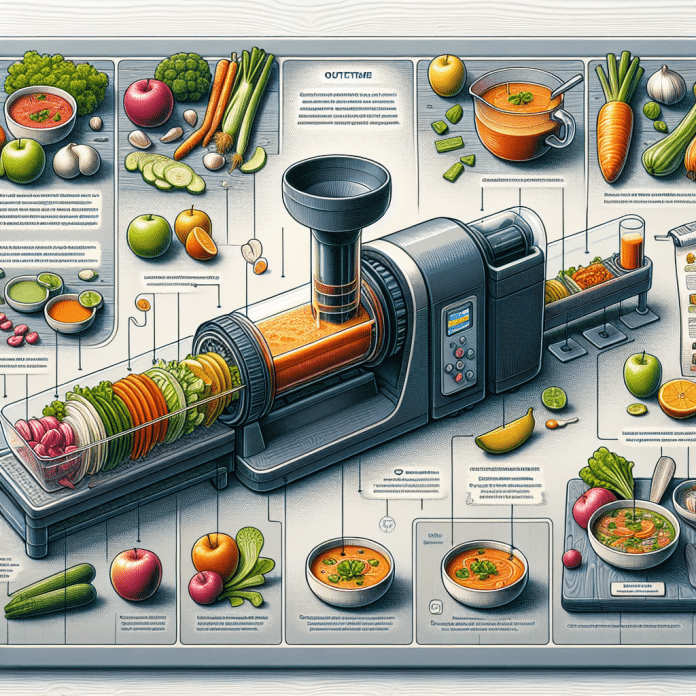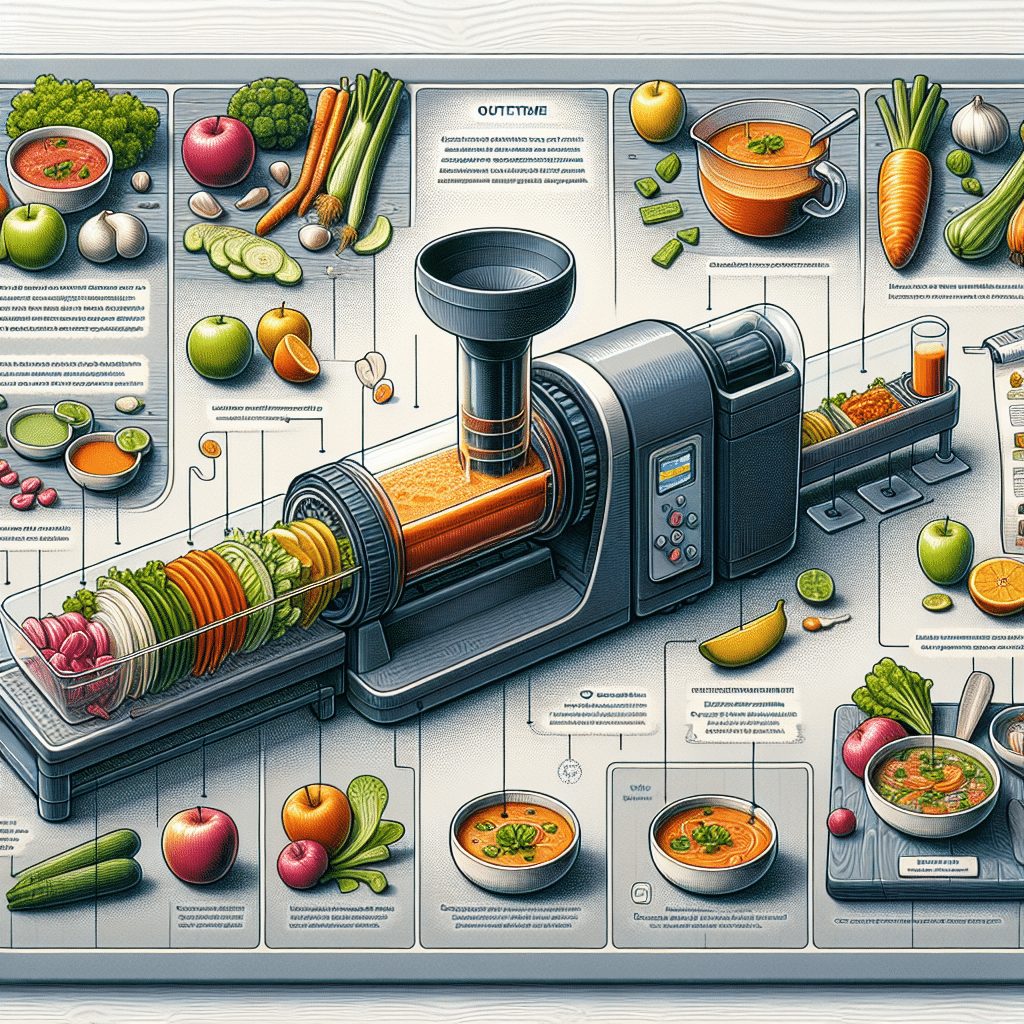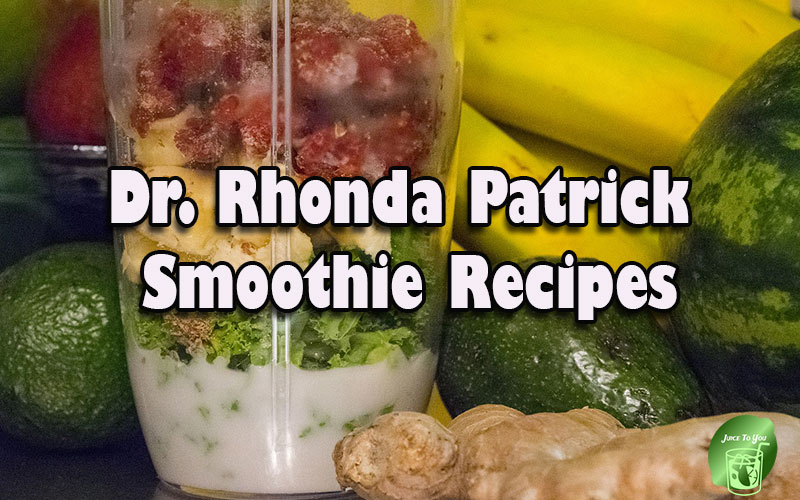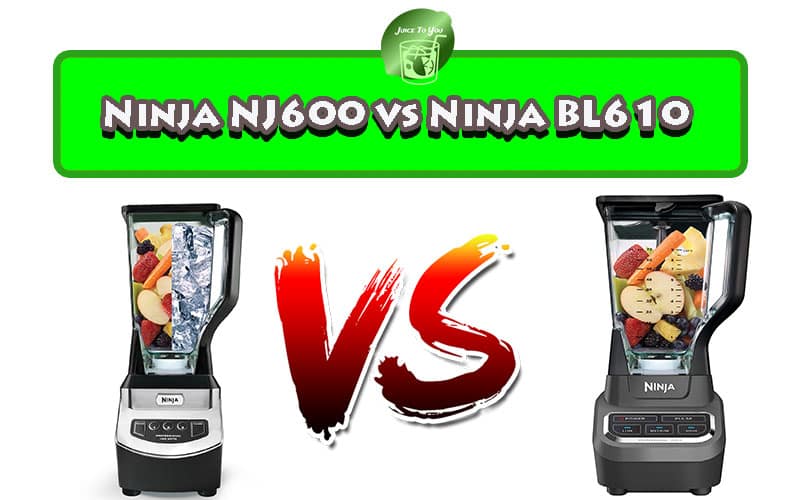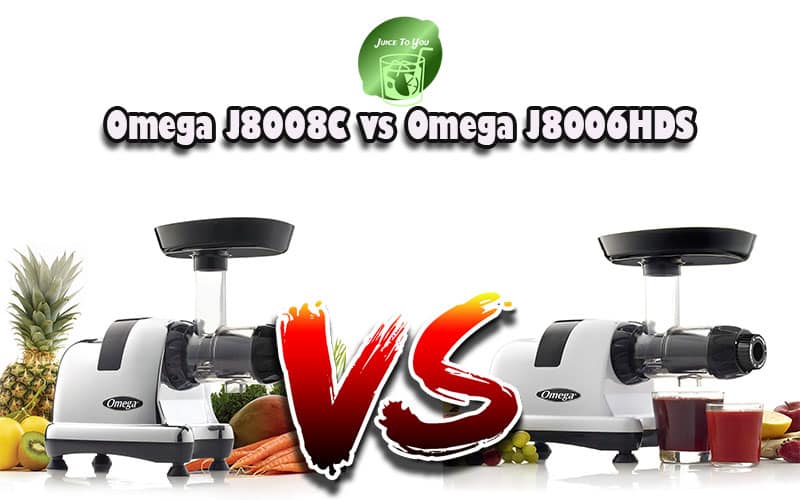Imagine being able to create delicious and nutritious soups and sauces right in the comfort of your own kitchen. Well, wonder no more, because masticating juicers might just be the answer you’ve been looking for. These incredible machines, known for their ability to extract the maximum amount of nutrients from fruits and vegetables, can also be used to whip up flavorful soups and sauces. In this article, we will explore the versatility of masticating juicers and discover how they can revolutionize your culinary creations. Get ready to unlock a whole new world of flavors!
Review contents
Overview of Masticating Juicers
Definition and Operation
Masticating juicers, also known as slow juicers or cold press juicers, are kitchen appliances that use a slow, grinding mechanism to extract juice from fruits and vegetables. Unlike centrifugal juicers which use high-speed spinning to extract juice, masticating juicers operate at a slower speed, crushing and chewing the produce to separate the juice from the pulp. This gentle extraction process helps preserve the nutrients, enzymes, and flavors of the ingredients.
Benefits and Advantages
Masticating juicers offer several benefits and advantages over other types of juicers. One major advantage is the high yield of juice they produce. Since the juicing process is slower and more thorough, masticating juicers are able to extract a higher percentage of juice from the fruits and vegetables they process. This not only saves money on produce, but also ensures that you get the maximum nutritional value from your juice.
Another benefit of masticating juicers is their versatility. In addition to extracting juice, many models of masticating juicers can also be used for creating a range of other foods. From making nut butters and baby food to preparing sauces and soups, these juicers provide a variety of options for expanding your culinary repertoire. Their slow and gentle operation also reduces oxidation and heat buildup, resulting in juice that stays fresher for longer.
Soups and Sauces: The Basics
Types of Soups
Soups are a popular and comforting dish enjoyed in many cultures around the world. There are various types of soups, each with its own unique characteristics and flavors. Some common types of soups include:
-
Clear Soups: These soups have a transparent, light broth that is typically made by simmering meat, vegetables, and aromatics.
-
Creamy Soups: Creamy soups are thick and velvety in texture, made by pureeing ingredients and incorporating dairy or cream for added richness.
-
Broth-Based Soups: These soups are made with a flavorful broth, often enriched with meat, vegetables, or pasta.
-
Chunky Soups: Chunky soups are hearty and substantial, containing large pieces of ingredients like meat, vegetables, and legumes.
Types of Sauces
Sauces play an important role in enhancing the flavors and textures of various dishes. They can be used to add moisture, richness, or tanginess to a meal. Some common types of sauces include:
-
Tomato Sauce: Made from tomatoes, herbs, and spices, tomato sauce is versatile and commonly used in pasta dishes, pizzas, and other Italian cuisine.
-
Cream Sauce: Cream sauces are rich and velvety, often made with a combination of ingredients such as cream, butter, and flour. They are commonly used in dishes like Alfredo pasta and creamy soups.
-
Hollandaise Sauce: Hollandaise sauce is a classic French sauce made from egg yolks, butter, and lemon juice. It is commonly served with eggs Benedict and other breakfast dishes.
-
Pesto Sauce: Pesto sauce originates from Italy and is made by blending fresh basil, garlic, pine nuts, Parmesan cheese, and olive oil. It is commonly used as a pasta sauce or mixed into dishes for added flavor.
Understanding Masticating Juicers
Definition and Function
Masticating juicers are designed to chew and grind fruits and vegetables to extract juice, using a slow and steady process. They operate at a low RPM (revolutions per minute), typically ranging from 40 to 100 RPM, which is significantly slower than centrifugal juicers.
The key component of a masticating juicer is an auger or a single gear. This auger rotates and crushes the produce against a screen or a mesh, extracting the juice while separating the pulp. The slow rotation speed ensures minimal heat generation, reducing oxidation and preserving the nutrients, enzymes, and flavors of the ingredients.
Types of Masticating Juicers
There are two primary types of masticating juicers: horizontal and vertical.
Horizontal masticating juicers have an auger that is positioned horizontally, which requires the ingredients to be fed into the juicer horizontally as well. These juicers are known for their versatility and ability to handle a wide range of ingredients, including leafy greens, hard fruits, and nuts.
Vertical masticating juicers have an auger that is positioned vertically, making them more compact and space-saving. They typically have a smaller feed chute, which may require ingredients to be cut into smaller pieces. Vertical juicers are known for their efficiency in extracting juice, especially from softer fruits and vegetables.
Can Masticating Juicers Make Soups?
Processing Ingredients
Yes, masticating juicers can be used to make soups. While their primary function is to extract juice, their versatility allows them to be used for a range of other cooking purposes, including soup-making. Masticating juicers can process ingredients by grinding and masticating them into a fine pulp, which can then be used as a base for soups.
Types of Soups that can be Made
Masticating juicers can be used to make a variety of soups, including both smooth and chunky varieties. The ability to extract juice from fruits and vegetables means that you can create flavorful and nutritious soups using a wide range of ingredients.
For smooth soups, you can process ingredients such as carrots, tomatoes, butternut squash, and even leafy greens like spinach or kale. These ingredients can be juiced using a masticating juicer and then heated or blended to create a creamy and nutritious soup base.
For chunky soups, you can extract juice from some ingredients and finely chop or dice others to create a diverse and textured soup. For example, you can juice tomatoes and blend them with diced onions, celery, and carrots to create a chunky tomato soup.
Benefits of Using Masticating Juicers for Soups
Using a masticating juicer for making soups offers several advantages. Firstly, the slow and gentle extraction process preserves the nutritional value and flavors of the ingredients, resulting in soups that are not only delicious but also packed with nutrients.
Secondly, using a masticating juicer allows you to incorporate a wide variety of fruits and vegetables into your soups. This means you can experiment with different flavors and combinations to create unique and nutritious soups that cater to your taste preferences.
Lastly, masticating juicers provide a convenient and efficient way to create soups. The juicing process efficiently extracts the juice from the ingredients, while the resulting pulp can be used as a flavorful base for soups. This reduces food waste and saves time in the kitchen.
Factors to Consider
Texture and Consistency
When using a masticating juicer for making soups, it is important to consider the desired texture and consistency of the end result. Masticating juicers are capable of creating both smooth and chunky soups, depending on how the ingredients are processed.
For a smoother soup, you can run the extracted juice through a blender or use an immersion blender to achieve the desired consistency. This will result in a soup with a velvety and uniform texture.
If you prefer a chunkier texture, you can process some ingredients by juicing them and finely chopping or dicing others. This combination of juiced and diced ingredients will create a soup with varying textures and flavors.
Temperature Control
Masticating juicers operate at a slow speed, which means they generate less heat compared to centrifugal juicers. However, when making soups, it is important to consider the temperature at which the ingredients are processed and cooked.
To preserve the nutrients and enzymes in the ingredients, it is recommended to heat the soup gently and avoid excessive cooking. This can be achieved by lightly simmering the soup on low heat after combining the juiced ingredients and additional seasonings.
Ingredients Compatibility
Not all ingredients are suitable for juicing in a masticating juicer. Some ingredients, such as starchy vegetables like potatoes or grains, may not yield a desirable result when juiced. It is important to consider the compatibility of the ingredients with the juicer and adjust the recipe accordingly.
Leafy greens, root vegetables, soft fruits, and some hard fruits are generally suitable for juicing in a masticating juicer. It is always a good idea to consult the juicer’s instruction manual or do some research to ensure that the ingredients you plan to juice are compatible with the juicer.
Recipes using Masticating Juicers
Carrot Ginger Soup
Ingredients:
- 6 large carrots, juiced
- 1-inch piece of ginger, juiced
- 1 small onion, diced
- 2 cloves of garlic, minced
- 4 cups vegetable broth
- Salt and pepper to taste
Instructions:
- Juice the carrots and ginger using a masticating juicer.
- In a large pot, sauté the diced onion and minced garlic until fragrant.
- Add the carrot and ginger juice to the pot, followed by the vegetable broth.
- Bring the mixture to a boil, then reduce the heat and let it simmer for 15-20 minutes.
- Season with salt and pepper to taste.
- Blend the soup using an immersion blender or a countertop blender until smooth.
- Serve hot and enjoy!
Tomato Basil Soup
Ingredients:
- 6 large tomatoes, juiced
- 1 small onion, diced
- 2 cloves of garlic, minced
- 1 cup vegetable broth
- 1/2 cup fresh basil leaves, chopped
- 2 tablespoons olive oil
- Salt and pepper to taste
Instructions:
- Juice the tomatoes using a masticating juicer.
- In a large pot, heat the olive oil over medium heat.
- Sauté the diced onion and minced garlic until softened.
- Add the tomato juice to the pot, followed by the vegetable broth.
- Bring the mixture to a boil, then reduce the heat and let it simmer for 15-20 minutes.
- Stir in the chopped basil leaves and season with salt and pepper to taste.
- Blend the soup using an immersion blender or a countertop blender until smooth.
- Serve hot and garnish with additional fresh basil if desired.
Butternut Squash Sauce
Ingredients:
- 1 medium butternut squash, juiced
- 1 small onion, diced
- 2 cloves of garlic, minced
- 1 cup vegetable broth
- 1/2 cup coconut milk
- 1 tablespoon olive oil
- 1 teaspoon ground cinnamon
- Salt and pepper to taste
Instructions:
- Juice the butternut squash using a masticating juicer.
- In a large saucepan, heat the olive oil over medium heat.
- Sauté the diced onion and minced garlic until softened.
- Add the butternut squash juice to the pan, followed by the vegetable broth and coconut milk.
- Stir in the ground cinnamon and season with salt and pepper to taste.
- Simmer the sauce over low heat for 20-25 minutes, stirring occasionally.
- Once the sauce has thickened, remove it from the heat.
- Serve the butternut squash sauce over pasta or roasted vegetables for a delicious and creamy dish.
Tips and Techniques
Preparation and Cutting Techniques
When using a masticating juicer for soup-making, it is important to prepare your ingredients properly. Here are some tips and techniques to keep in mind:
-
Wash and clean your fruits and vegetables thoroughly before juicing them to ensure they are free from dirt and debris.
-
If the masticating juicer has a small feed chute, consider cutting your ingredients into smaller pieces to make the juicing process smoother and more efficient.
-
Remove any tough stems, seeds, or skins from the ingredients before juicing. These can affect the texture and taste of the soup.
Blending and Cooking Methods
After using the masticating juicer to extract the juice, you will likely need to further process the ingredients to achieve the desired texture and consistency of your soup. Here are some tips for blending and cooking:
-
To blend the juiced ingredients into a smooth soup, use an immersion blender or a countertop blender. Start by blending on low speed and gradually increase the speed until the desired consistency is achieved.
-
If you prefer a chunkier soup, reserve some of the juiced ingredients and finely chop or dice them. Combine the diced ingredients with the juiced ones to create a textured and chunky soup.
-
When cooking the soup after juicing, use low to medium heat to prevent overcooking and preserve the nutrients in the ingredients. Stir occasionally to ensure even heating and to prevent sticking.
Adding Seasonings and Spices
To enhance the flavors of your soup, it is important to add the right seasonings and spices. Here are some suggestions:
-
Fresh or dried herbs, such as basil, thyme, or oregano, can add depth and complexity to your soup. Add them towards the end of the cooking process to preserve their fresh flavors.
-
Salt and pepper are essential seasonings that can help enhance the overall taste of the soup. Add them gradually and taste while cooking to achieve the desired seasoning level.
-
Experiment with other spices and seasonings according to your preferences. For example, you can add cumin and paprika for a smoky flavor or curry powder for an oriental twist.
Cleaning and Maintenance
Disassembly and Cleaning Process
Keeping your masticating juicer clean and well-maintained is vital for its longevity and optimal performance. Here’s a step-by-step guide for disassembling and cleaning your masticating juicer:
-
Unplug the juicer from the power source and make sure all components have cooled down before starting the cleaning process.
-
Begin by removing the juice collection container from the juicer and pouring out any remaining juice.
-
Carefully disassemble the various parts of the juicer, following the manufacturer’s instructions. This usually involves detaching the hopper, auger, juicing screen, and pulp container.
-
Rinse the removable parts under warm water to remove any remaining pulp or juice. Use a soft brush or sponge to gently scrub away any residue.
-
Dry the parts thoroughly with a clean towel or air dry them before reassembling the juicer.
-
Wipe the exterior of the juicer with a damp cloth to remove any dirt or stains.
-
Once all the components are clean and dry, reassemble the juicer and make sure each part is securely attached.
Maintenance Tips to Keep the Juicer in Good Condition
Regular maintenance and care are essential to keep your masticating juicer functioning optimally. Here are some maintenance tips to consider:
-
Read the manufacturer’s instructions carefully, as different juicers may have specific cleaning and maintenance requirements.
-
Avoid using harsh or abrasive cleaning agents on the juicer parts, as they can damage the materials and affect the performance of the juicer.
-
Periodically lubricate the moving parts of the juicer, such as the auger and gears, with food-grade oil, as recommended by the manufacturer.
-
Store the juicer in a clean and dry location, away from direct sunlight, excess heat, or moisture.
-
Regularly inspect and replace any worn or damaged components to maintain the efficiency and longevity of the juicer.
Other Uses of Masticating Juicers
Making Nut Butters
Masticating juicers can also be used to make homemade nut butters. By grinding nuts like almonds or cashews, you can create creamy and nutritious spreads that are free from additives or preservatives. Simply feed the nuts through the juicer’s grinder or use the blank attachment specifically designed for making nut butter.
Creating Baby Food
The slow and gentle extraction process of masticating juicers makes them ideal for creating homemade baby food. By juicing or pureeing fruits, vegetables, and cooked meats, you can create nutrient-rich and flavorful food for your little one. The smooth consistency and concentrated nutrients of the baby food can be easily achieved with a masticating juicer.
Preparing Nut Milk
Masticating juicers can also be used to prepare homemade nut milk from nuts like almonds, cashews, or hazelnuts. By grinding the soaked nuts and then straining the mixture, you can extract the milk, which can be used as a dairy-free alternative in various recipes. The slow extraction process helps retain the nutrients and natural flavors of the nuts.
Conclusion
Masticating juicers offer a versatile and efficient way to create not only refreshing juices but also a range of other foods, including soups and sauces. With their slow and gentle process, these juicers preserve the nutritional value and flavors of the ingredients, resulting in healthier and more vibrant dishes. Whether you’re in the mood for a smooth and creamy soup or a chunky and textured sauce, a masticating juicer provides the flexibility to experiment with various ingredients and flavors. With proper care and maintenance, a masticating juicer can be a valuable addition to your kitchen, allowing you to explore new culinary possibilities while enjoying the benefits of fresh and nutritious meals.

